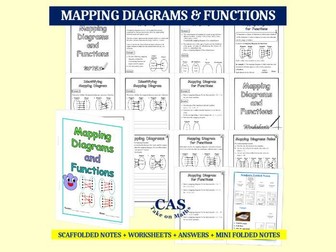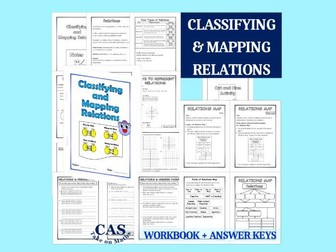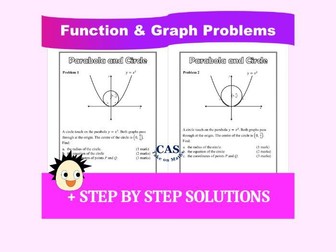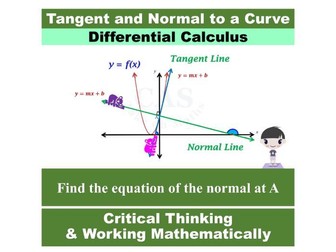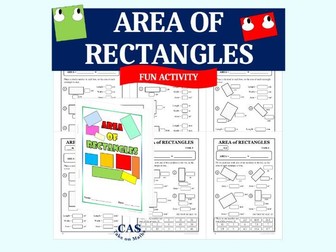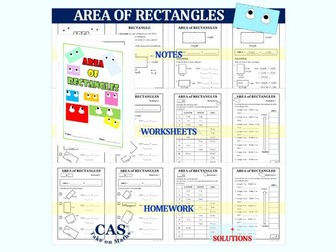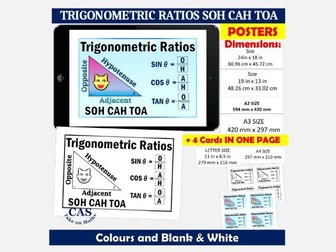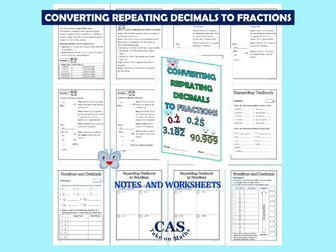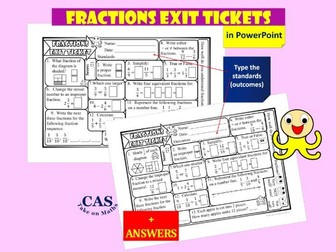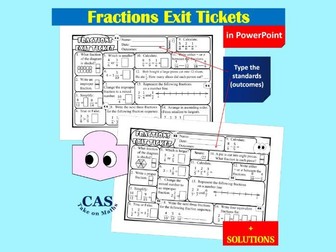Mapping Diagrams and Functions Workbook
<p><strong>MAPPING DIAGRAMS AND FUNCTIONS WORKBOOK</strong></p>
<p>Scaffolded notes + worksheets + solutions + mini folded notes to learn and practise:</p>
<ul>
<li>Understand that a mapping diagram consists of two parallel columns connected by lines or arrows that show the relationship between input and output values.</li>
<li>Explain the relationship between the inputs and the outputs of mapping diagrams.</li>
<li>Draw a mapping diagram of the ordered pairs.</li>
<li>Determine whether the mapping diagrams represent a function.</li>
<li>Draw a mapping diagram for functions.</li>
<li>There are two styles of the workbook.</li>
</ul>
<ul>
<li>
<p>Style 1: Cover, fill in the blank notes and worksheets</p>
</li>
<li>
<p>Style 2: Cover, completed (filled) notes and worksheets</p>
</li>
</ul>
<p>Total pages in each workbook: 14</p>
<p>Easy classroom preparation:</p>
<ul>
<li>For workbook: Just print and staple all pages together to make a book.</li>
<li>For Mini folded note: print, fold and glue the pages to make a mini notebook.</li>
</ul>
<p>Grades: 9th & 12th</p>
<p><strong>Learning Outcomes:</strong></p>
<ul>
<li>Define and use a relation as mappings between sets and as a rule or a formula that defines one variable quantity in terms of another.</li>
<li>Identify types of relations on a given domain and range (ordered pairs) using mapping diagrams.</li>
<li>Understand that a function is a rule that assigns to each input exactly one output. The graph of a function is the set of ordered pairs consisting of an input and the corresponding output.</li>
</ul>
<p>Also comply with Australian Curriculum:<br />
Use function notation, domain and range, independent and dependent variables (ACMMM023)<br />
Understand the concept of the graph of a function (ACMMM024)</p>
<p>Other Resource about Mapping Diagrams and Relations<br />
[Functions-Classifying and Mapping Relations Workbook] (</p>
<p>More Resources:<br />
<a href="https://www.tes.com/resources/search/?q=colouring%20page%20castakeonmaths">Colouring Pages</a><br />
<a href="https://www.tes.com/resources/search/?q=fun%20activity%20castakeonmaths">Fun Activity</a></p>
<p>Topics:<br />
<a href="https://www.tes.com/resources/search/?q=numbers%20castakeonmaths">Numbers</a><br />
<a href="https://www.tes.com/resources/search/?q=times%20table%20castakeonmaths">Times Table</a><br />
<a href="https://www.tes.com/resources/search/?q=fractions%20castakeonmaths">Fractions</a><br />
<a href="https://www.tes.com/resources/search/?q=decimals%20castakeonmaths">Decimals</a><br />
<a href="https://www.tes.com/resources/search/?q=percentages%20castakeonmaths">Percentages</a><br />
<a href="https://www.tes.com/resources/search/?q=significant%20figures%20castakeonmaths">Significant Figures</a><br />
<a href="https://www.tes.com/resources/search/?q=consumer%20maths%20castakeonmaths">Consumer Maths</a><br />
<a href="https://www.tes.com/resources/search/?q=financial%20maths%20castakeonmaths">Financial Maths</a><br />
<a href="https://www.tes.com/resources/search/?q=algebra%20%20castakeonmaths">Algebra</a><br />
<a href="https://www.tes.com/resources/search/?q=pythagoras%20castakeonmaths">Pythagoras Theorem</a><br />
<a href="https://www.tes.com/resources/search/?q=measurement%20castakeonmaths">Measurement and Geometry</a><br />
<a href="https://www.tes.com/resources/search/?q=functions%20castakeonmaths">Functions</a></p>
<p><a href="https://www.tes.com/teaching-resources/shop/castakeonmaths">Visit my shop :)</a></p>
